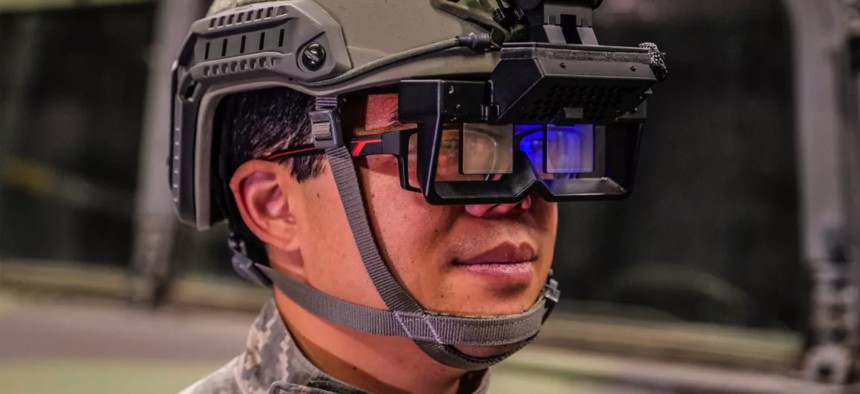
360 Display headset Honeywell
Honeywell shows off augmented-reality headset for tank crews
The goggles are meant to give soldiers in specially-equipped armored vehicles a clear view of the outside.
Move over, F-35 pilots. Tech giant Honeywell wants to give tank crews their own X-ray vision.
Unveiled at this week’s AUSA show in Washington, D.C., the 360 Display clicks into the helmet mount currently used for night vision goggles. It’s designed to mirror human vision, so even with prescription glasses on, the user can see what’s in front of them—up, down, and all around.
The 360 Display’s “near-to-eye system” uses technology intended to prevent the kind of motion sickness and nausea that bedeviled pilots who tested early versions of the F-35 helmet.
“There's a very specific technology that we implemented to basically make your body think that it's looking with its own two eyes, it doesn't have any augmentation into it. That's really what makes our system very special,” said Adam Gavrich, the company’s senior technical sales manager for avionics. “The primary use case on the ground side is to be able to operate a vehicle like this at a high rate of speed, fully occluded, fully under armor, meaning there's no outside visual reference and do that without the operator getting sick.”
The headset could be used on an Abrams tank—or any situation where there’s limited visibility. Gavrich said the company is looking to bring the tech to the commercial mining and wild-firefighting industries where vision is occluded by smoke or caverns.
“It's gonna help situational awareness. It's also stereoscopic, so they have a sense of depth when they're looking out, so it's going to prevent vehicle rollover. So it's an increase in safety. It's an increase in operational capability. And you can add more armor to the vehicle because you don't need as many windows if any windows at all.”
Here’s what Defense One learned from demoing the headset:
- The line-of-sight images, at least indoors under fluorescent lights on the conference show floor, were clear, with lo-fi color saturation, almost like security-camera footage.
- The heads-up, picture-in-picture displays showed other angles of the vehicle, including one from directly above. Those were crisp and almost seemed like floating HD television images. Other displays showed the odometer, compasses, and waypoints.
- The views were overlaid with lines showing the vehicle’s trajectory and included fields of view of everyone wearing a headset.
After the demo, we still had questions. So here’s what Gavrich had to say about the technology's plans and how it stands up to other sets like the Army’s Integrated Visual Augmentation System, or IVAS:
Does it come with cameras and sensors?
We're camera/sensor-agnostic. That's very important. So we don't actually supply the cameras, or the sensors. We can integrate with all different types of cameras and sensors. That's part of what makes the system unique. It's really the headset, equipment. And that's the software that does all of that computation and rendering.
How is this different from IVAS?
IVAS is for the dismounted soldier to augment his vision as he's walking around. This is a mounted, primarily operational, system for operating a vehicle. So it's designed to operate a vehicle and to get situational awareness for crew members in a vehicle. But it's not worn once the soldier dismounts.
What sort of demand signal were you getting for developing this?
The Army is starting to release a lot of different requirements that are specifying [360-degree situational awareness] systems [that] have exactly what we've built here. So there's a large demand from the military side. We're also getting some demand from the commercial side as well.
Has it been ruggedized and field tested?
It's being field-tested. The productization phase that we're in is where we're ruggedizing it. So that's what we're starting to do right now.
Where is it being tested?
There are several military entities that are operating it in a prototype fashion. We also tested on this [Humvee] at Honeywell and have it [in] some other programs working on the commercial side from a test perspective.
When do you expect to see this on contract? What other plans do you have for it in the coming year?
We're gonna be really focused on equipping military vehicles that need this type of capability. Then also looking at the vehicle spaces that can really benefit from it—like I said, commercial mining because they have large trucks that they have to look through blind spots, and often operate and austere locations or where the visibility is poor sometimes. Those are really where we're focused on moving in. There's also aviation applications as well. Right now, we're really focused on our ground side.


